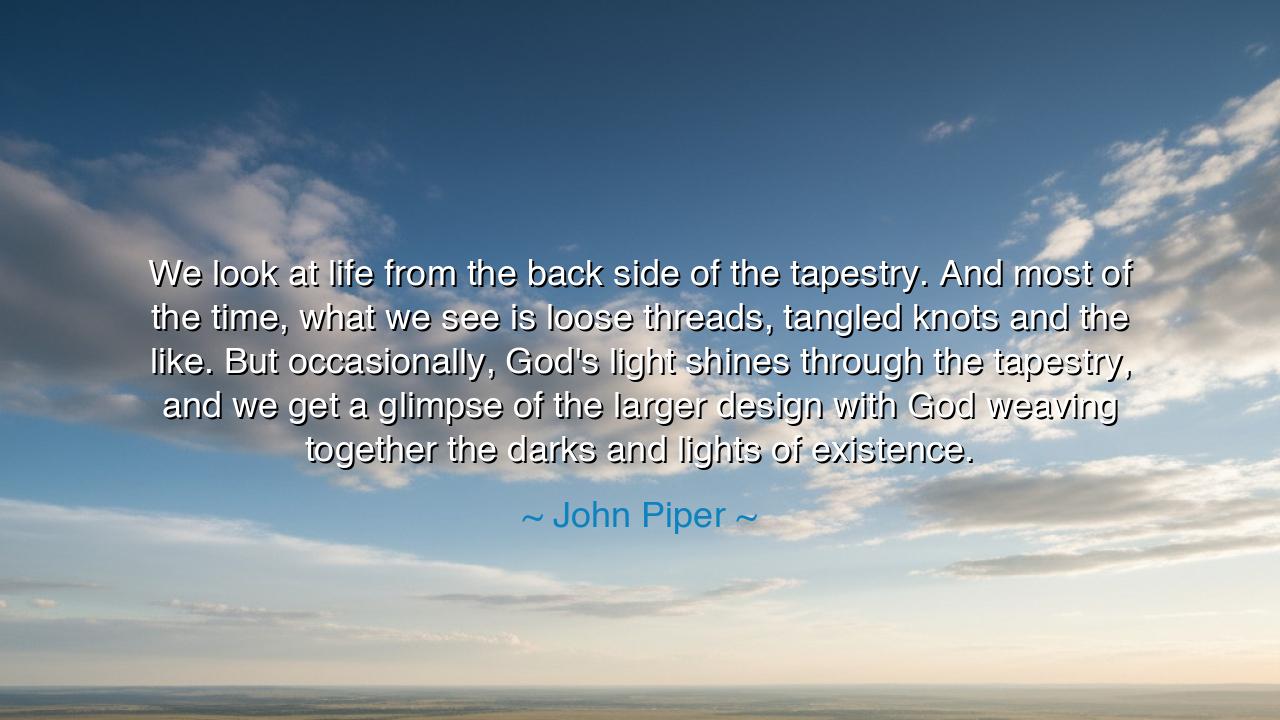
We look at life from the back side of the tapestry. And most of
We look at life from the back side of the tapestry. And most of the time, what we see is loose threads, tangled knots and the like. But occasionally, God's light shines through the tapestry, and we get a glimpse of the larger design with God weaving together the darks and lights of existence.






When John Piper, the preacher and theologian of faith and endurance, wrote, “We look at life from the back side of the tapestry. And most of the time, what we see is loose threads, tangled knots and the like. But occasionally, God's light shines through the tapestry, and we get a glimpse of the larger design with God weaving together the darks and lights of existence,” he offered not merely an image of comfort, but a revelation of divine perspective. His words remind us that what seems to us chaos and confusion may, from the hand of God, be part of a perfect and hidden harmony. For we are creatures bound by time, seeing only fragments; yet the Eternal Weaver sees the whole cloth — every thread, every shade, every twist — as part of His grand design.
The origin of this quote comes from Piper’s reflections on suffering and providence, teachings born from the ancient soil of Christian thought and nourished by his own years of pastoral care. Drawing upon imagery as old as the weaver’s loom, Piper echoes the wisdom of Saint Paul, who wrote, “Now we see through a glass, darkly; but then face to face.” To the human eye, life often appears disordered, a mass of broken hopes, misfortunes, and unanswered prayers. But to the divine mind, these tangled strands form a masterpiece of purpose and redemption. What looks like loss is often preparation; what feels like darkness is the shadow of a deeper light. Piper’s tapestry is a parable — a reminder that faith is the trust to believe in beauty we cannot yet see.
In this vision, the “back side of the tapestry” represents the human condition — our limited view of time and meaning. We see suffering, failure, and confusion as disconnected fragments, as if life were woven by accident. Yet Piper invites us to imagine that, on the other side, where the Maker dwells, the threads come together into patterns of astonishing symmetry. The roughness and disorder that we experience from below are, from above, the structure of glory itself. This is not a denial of pain but a transformation of it — a sacred reordering where even sorrow has purpose.
There is an old story told of a young woman who once visited an elderly weaver in his shop. She saw before him a great loom covered with hanging threads of every color — some bright as the dawn, others dark as ash. From her angle, it seemed chaotic, senseless. “How can such a tangle become beautiful?” she asked. The old weaver smiled and turned the frame around. On the other side, she beheld a magnificent image — a scene of sunrise over mountains, the dark threads forming the shadow that made the light glow brighter. “Every knot,” said the weaver, “holds the design together.” So it is with God’s work in the world: our pain becomes the shadow that gives contrast to His light.
History itself bears witness to this truth. Consider the life of Joseph, sold into slavery by his own brothers, imprisoned by false accusation, forgotten by those he helped. To all appearances, his life was a snarl of loose threads and tangled knots. Yet, when the famine came, and Joseph rose to power in Egypt, it was through those very hardships that he was able to save nations from hunger — even the family that betrayed him. Looking back, Joseph said, “You meant it for evil, but God meant it for good.” In that moment, the backside of the tapestry turned, and the divine design — invisible through years of trial — shone clear as the morning.
Piper’s metaphor also carries a message for the modern soul, so often restless, impatient, and doubtful. We live in an age that demands clarity, where mystery is treated as failure. Yet life’s deepest truths cannot be forced to reveal themselves on command. The tapestry is revealed only in moments of grace, when the light of understanding passes through, and the heart glimpses the unity behind its own suffering. Those who learn patience, who trust that their tangled threads are held by unseen hands, will find peace even amid confusion. For faith is not blindness; it is the vision to believe that what we see is not all that is.
So, O child of time, take this wisdom into your heart: when life seems tangled and your path obscured, remember that you are standing on the wrong side of the tapestry. What seems random is woven with care; what feels meaningless may be part of a greater mercy. Trust the Weaver. Let patience be your thread and hope your loom. Continue the work you are given — loving, enduring, believing — and in moments of quiet reflection, when the light of God shines through the cloth of your days, you may catch a glimpse of the beauty being formed.
And when that day comes — whether in this life or beyond — you will see that no thread was wasted, no knot without purpose. The darks and lights together will reveal a pattern so vast and radiant that you will marvel at the wisdom of the One who wove it. Then you will understand, as Piper understood, that life’s brokenness is but the back of a masterpiece — and the hand that weaves it is the hand of love eternal.






AAdministratorAdministrator
Welcome, honored guests. Please leave a comment, we will respond soon